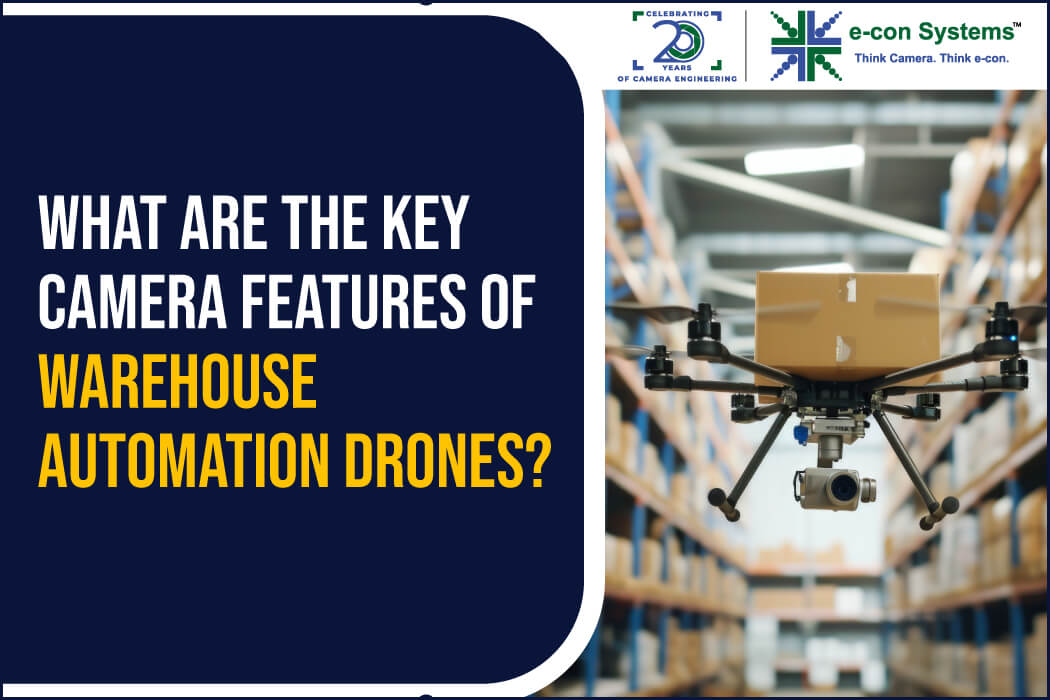Warehouse drones are built to be compatible with operating inside warehouses and distribution centers and fit for the indoor environment and operations. The key component of warehouse drones is their vision systems. These drones are built with robust collision avoidance systems using advanced vision sensors and camera technologies.
The accuracy of navigation, analysis, and decision-making of warehouse drones relies on the camera systems, sensors, and image processing algorithms integrated into them.
Why Warehouse Automation Drones?
Warehouse drones perform data collection, floor mapping, inventory management, etc., which help streamline operations and improve efficiency. These drones consistently scan QR codes or RFID tags to track inventory levels, fly through aisles to perform stock checks, locate items, and update inventory databases in real time. Some of their benefits include:
Increased Efficiency: Implementing warehouse drones for inventory management can exponentially reduce the time taken for tasks such as stock-taking. Drones also reduce manual labor, trimming operational costs and making it a valuable investment.
Enhanced Accuracy: Automated inventory tracking, combined with RFID and QR scanning capabilities, offers real-time and accurate data. The automation of tasks by drones reduces human-caused errors.
Improved Safety: Traditional warehouse setup involves high altitude shelves and heavy inventory, which are potential risk factors while operating. Drones can safely navigate these heights with the advanced sensors integrated into them, ensuring a safer work environment.
Scalability: Drones can be easily integrated into larger warehouse layouts without affecting the operational streamline.
Camera Features Essential for High-Performance Warehouse Drones
High-Resolution
High-resolution cameras are required to capture sharp and detailed images. Having a high-resolution visual system helps drone cameras differentiate between various items, labels, or QR codes within the warehouse environment. A high-resolution camera also helps in better navigation of drones, avoiding obstacles.
High-resolution cameras also offer zooming features without pixelation. As drones are required to fly at a pre-defined height, this enhanced zooming capability comes in handy throughout drones’ operations. High-resolution cameras also perform better in varied lighting conditions. It is equipped with improved sensor sensitivity to adapt to low-lighting conditions. This ensures image quality, regardless of the lighting environment within the warehouse.
Faster Shutter Speed
As drones are in motion continuously, faster shutter speeds help freeze the movement, capturing sharper images without blur. This is particularly important when capturing fast-moving subjects or when the drone itself is moving swiftly.
Wider FOV
Warehouses can have complex layouts with shelves, aisles, and various obstacles. A wider FOV allows the drone to see more of its environment in a single frame, enabling better navigation and more assured avoidance of obstacles. A wider FOV also enables the drone to capture a larger portion of the warehouse floor in a single shot, making inventory checks more efficient and reducing t he time required to scan and analyze products on shelves.
A wider FOV assists in optimizing the path-planning algorithms of warehouse drones. With a broader view, the drone can better analyze the layout of the warehouse, plan routes, and adapt to changes in real time, improving overall operational efficiency.
Low-Light Performance
Warehouses often operate around the clock, and there may be instances where the lighting conditions are suboptimal, such as during nighttime or in poorly lit areas. A drone camera with good low-light performance helps the drone continue its operations effectively during these low-light situations, extending its operational hours.
Low-light capabilities can accurately capture details of products in poorly lit sections, helping in efficient inventory management and reducing the likelihood of errors in stock monitoring. Drones often use visual information for navigation and path planning. A camera with excellent low light performance ensures that the drone can effectively navigate through different parts of the warehouse, regardless of the lighting conditions.
Global Reset Release
Global Reset Release (GRR) is a mechanism used in electronic rolling shutter cameras. It is a shutter efficiency enhancement mode that can be introduced to reduce the rolling shutter artifacts in the cameras with an electronic rolling shutter. This mode can help in delivering smooth and clearer visuals while capturing fast-moving objects. As drone cameras are constantly in motion, cameras with GRR mode are highly beneficial in acquiring noise-less, comprehendible visual data.
Read: What is Global Reset Release? How does it work?
How e-con Systems’ Cameras Enhance Warehouse Automation Drones
e-con Systems is an industry pioneer with 20+ years of experience in designing, developing, and manufacturing OEM cameras.
We have newly launched a high-resolution AR2020 sensor-based camera, e-CAM200_CUMI2020C_MOD, integrated with advanced image processing software. This high-performance 5K camera seamlessly interfaces with NVIDIA® Jetson AGX Orin™, Jetson Orin™ NX, Jetson Orin Nano™, and Qualcomm® Robotics RB5. It also offers versatile interface options, supporting GMSL and MIPI, with seamless integration capability. The e-CAM200_CUMI2020C_MOD is designed to excel in low-light environments, offering enhanced NIR performance. Its high frame rate feature makes it ideal for indoor warehouse settings.
The e-CAM200_CUMI2020C_MOD also supports a unique feature called smart ROI. The camera is capable of dual streaming in the smart ROI mode. One streaming will cover the entire FOV (wide FOV), and the second streaming is set to cover only a defined ROI (narrow FOV). This feature can prove highly beneficial for the drone’s working environment, providing good-quality visuals and a larger FOV simultaneously.
The key features of the e-CAM200_CUMI2020C_MOD are:
- Expert ISP Fine-Tuning for Superior Image Quality
- Multi-Camera Support
- Low-light and NIR Excellence
- Smart ROI
- Wake on Motion Detection and SLP
We are also launching a USB variant of the AR2020 sensor-based camera called See3CAM_CU200 soon.
We also provide customization services tailored to meet your application demands. For instance, cameras used in warehouse drones often demand an additional set of advanced features pertaining to the challenging environments in which they operate. An example is the drone being in constant motion; an auto-focus capability for the camera would prove highly beneficial to capture the subject with focus. Our newly launched e-CAM200_CUMI2020C_MOD can be customized to include this feature and a lot more.
Get to know us better and visit our Markets Page.
Take a look at our Camera Selector Page to find out the right camera catering to your application needs.
You can also write to us at camerasolutions@e-consystems.com. We will help you find and integrate the right camera into your application.

Gomathi Sankar is a camera expert with 15+ years of experience in embedded product design, camera solutioning, and product development. In e-con Systems, he has built numerous camera solutions for robots, industrial handhelds, quality inspection systems, smart city applications, industrial safety systems, and more. He has played an integral part in helping hundreds of customers build their dream products by integrating the right vision technology into them.




